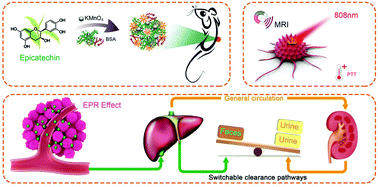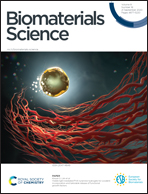On/off switchable epicatechin-based ultra-sensitive MRI-visible nanotheranostics – see it and treat it†
Abstract
Nanotechnology has a remarkable impact on the preclinical development of future medicines. However, the complicated preparation and systemic toxicity to living systems prevent them from translation to clinical applications. In the present report, we developed a polyepicatechin-based on/off switchable ultra-sensitive magnetic resonance imaging (MRI) visible theranostic nanoparticle (PEMN) for image-guided photothermal therapy (PTT) using our strategy of integrating polymerization and biomineralization into the protein template. We have exploited natural polyphenols as the near infra-red (NIR) switchable photothermal source and MnO2 for the MRI-guided theranostics. PEMN demonstrates excellent MRI contrast ability with a longitudinal relaxivity value up to 30.01 mM−1 s−1. PEMN has shown great tumor inhibition on orthotopic breast tumors and the treatment could be made switchable with an on/off interchangeable mode as needed. PEMN was found to be excretable mainly through the kidneys, avoiding potential systemic toxicity. Thus, PEMN could be extremely useful for developing on-demand therapeutics via ‘see it and treat it’ means with distinguished MRI capability and on/off switchable photothermal properties.



 Please wait while we load your content...
Please wait while we load your content...